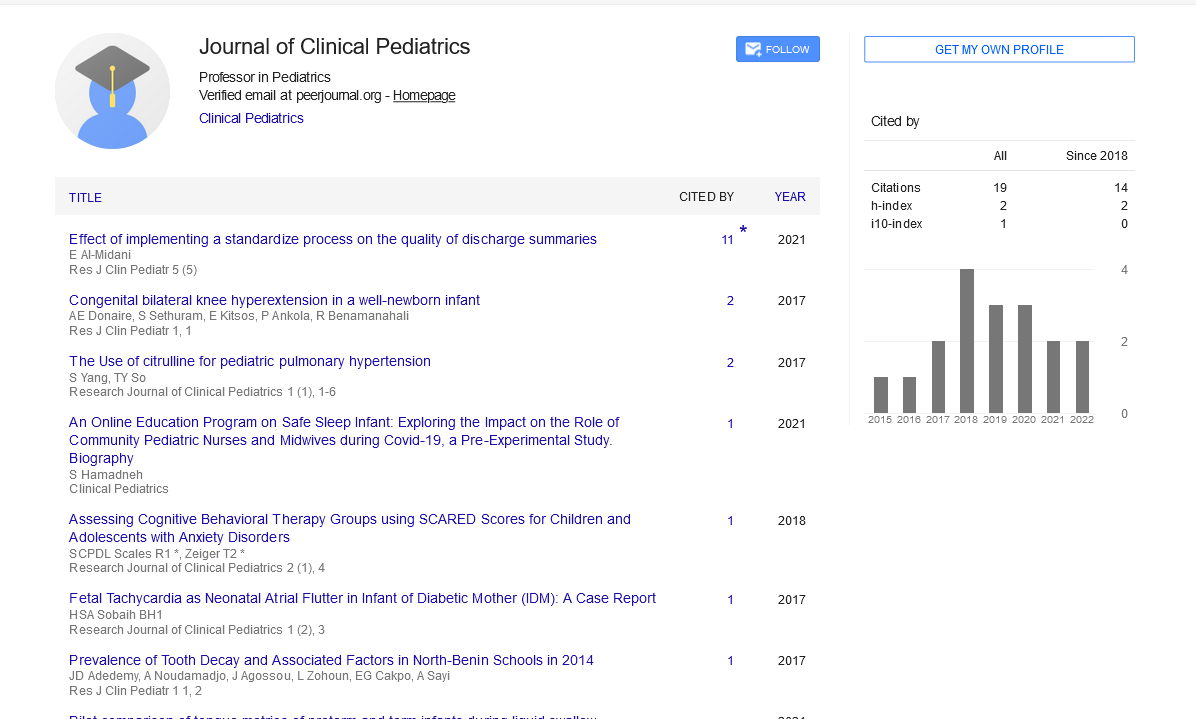Opinion Article, Res J Clin Pediatr Vol: 6 Issue: 2
Observations of Juvenile Dermatomyositis at One Center-A New Perspective
Elzbieta Smolewska*
Department of Pediatric Cardiology, Medical University of Lodz, Tadeusza KoÅ?ciuszki, Poland
*Corresponding Author: Elzbieta Smolewska
Department of Pediatric Cardiology, Medical University of Lodz, Tadeusza KoÅ?ciuszki, Poland
Email: e.smolewskaa@wp.pl
Received date: 25 February, 2022, Manuscript No. RJCP-22-56272;
Editor assigned date: 28 February, 2022, PreQC No. RJCP-22-56272(PQ);
Reviewed date: 11 March, 2022, QC No RJCP-22-56272;
Revised date: 22 March, 2022, Manuscript No. RJCP-22-56272(R);
Published date: 09 April, 2022, DOI: 10.4172/rjcp.1000122.
Citation: Smolewska E (2022) Observations of Juvenile Dermatomyositis at One Center-A New Perspective. Res J Clin Pediatr 6:2.
Keywords: Dermatomyositis
Introduction
The most frequent inflammatory myopathy in children is Juvenile Dermatomyositis (JDM). Bohan and Peter's diagnostic criteria were created with adults in mind. The wide variety of clinical variations in dermatomyositis between adults and children has prompted a reevaluation of the existing criteria. The goal of this study was to look at the clinical course and response to pharmacological therapy in young patients with dermatomyositis, as well as laboratory and electromyography data. Between October 2000 and November 2014, 5 children with JDM were admitted to the department of pediatric cardiology and rheumatology at the Medical University of Lodz in Poland. Demographic information, clinical symptom characteristics, laboratory tests, EMG and muscle biopsy reports, and therapy response were all examined.
In 80% of patients, muscle weakness was the most prevalent complaint. Heliotrope rash (60%) and gottron sign were also observed in more than half of the individuals (60%). In four out of five patients, muscle enzyme levels were significantly raised. Electromyography (E) and muscle biopsy were performed on three patients and found to be positive in all three cases. Prednisone 1 mg/day was given to all patients as an initial treatment, along with a disease-modifying antirheumatic medication, the most prevalent of which being methotrexate (60%). Rhabdomyolysis, severe calcinosis, and elbow contractures, worsening following GCS dose decrease; hypertriglyceridemia, steatohepatitis, and tachycardia were among the complications seen in the patients. Our research uncovered some unique features of JDM's clinical progression. In order to tailor diagnostic criteria to pediatric patients, more research is needed.
Rare Systemic Disease in Cutaneous Systems
JDM (Juvenile Dermatomyositis) is a rare systemic disease that primarily affects the musculoskeletal and cutaneous systems. JDM is the most frequent inflammatory myopathy in pediatric patients, affecting 2-3 children per million every year. Classical JDM manifests with progressive muscle weakness, easy fatigue, skin rash and fever. Nonetheless, its course varies from mild muscle symptoms that are easy to treat and never relapse, to a therapy-resistant chronic condition. JDM diagnosis is based on the Bohan and Peter criteria originally developed for adult patients: Symmetric proximal muscle weakness, biopsy-proven myositis, elevated serum muscle enzyme levels, electromyography changes of myositis. JDM may be also misdiagnosed as poly myositis in patients presenting with isolated muscle symptoms on first admission.
The pathogenesis of JDM is not completely understandable yet. Viral infection or immune dysfunction may trigger disease in patients with genetic predispositions. Accordingly, the identification of novel autoantibodies in JDM may have clinical implications, as they are associated with specific clinical features, treatment response and prognosis. Dermatomyositis is also considered as one of para neoplastic syndromes in adults. It is believed to occur in 7%-15% of all cancer patients. The association of dermatomyositis and cancer is more likely to happen in elderly people, but it may also coincide with leukemia and lymphoma in pediatric patients. As JDM differs from the course of disease in adults, diagnostic criteria require a new approach. They do not consider radiologic methods such as MRI, which is recently becoming the preferred non-invasive test indicating muscle inflammation, instead of muscle biopsy and Electromyography (E) included in the criteria. In order to adjust criteria to pediatric patients, differences in clinical course of dermatomyositis between adults and children need to be reported. Therefore we present series of 5 cases.
Clinical Presentations of Cardiology and Rheumatology
The medical records of eight patients aged 18 who were treated at the department of pediatric cardiology and rheumatology, medical university of Lodz, between October 2000 and November 2014 for suspected JDM were included in the retrospective analysis. The clinical presentations of the patients, the findings of laboratory tests, and the clinical outcomes were all documented in these charts. In every case, the entire patient's history was examined, not just the initial hospitalizations. Three participants were dropped from the research after failing to be diagnosed with JDM.
The following parameters were recorded: Gender, age at diagnosis, duration of symptoms, initial manifestations, EMG and muscle biopsy reports, laboratory data, medication use, and clinical complications. Duration of symptoms was defined as the time period from disease onset until diagnosis. Creatine Kinase (CK), Lactate Dehydrogenase (LD), Erythrocyte Sedimentation Rate (ESR), the activity of aspartate and alanine amino transpherase and presence of autoantibodies were particularly checked among the results of laboratory tests. Every patient was verified whether initial symptoms involved lesions characteristic for JDM such as pathognomonic gottron sign (erythematous rash or scaly eruptions typically over the extensor joint surfaces), heliotrope rash accompanied by per orbital edema.
The sample was too small to perform statistical analyses. Furthermore, the descriptive character was the original assumption of the study.
Evaluation of Pathognomonic Symptoms
Our evaluation of clinical course in 5 patients revealed both typical and uncharacteristic symptoms and complications of JDM. Gottron sign, which is described as pathognomonic symptom of the disease, was noted in 3 cases. Characteristic manifestations, such as muscle weakness, heliotrope rash, muscle pain and fever, were also observed. Additional, non-specific symptoms found in analyzed patients included: Lupus-like butterfly rash, hair loss, macular rash on nose, scar-like lesions on hands, fibromatous tumor in the posterior region of the neck, pneumonia on first admission. Findlay et al. listed other symptoms occurring in patients with JDM: V sign (erythematous macular rash on the face, neck and chest), shawl sign (when rash is located on the back of the neck and shoulders), hyperkeratosis, horizontal fissures on the palms, periungual telangiectasia. These manifestations were not observed in our patients though. As mentioned before, MRI is frequently performed during diagnostic process in place of EMG and muscle biopsy included in the criteria. Sanyal et al. also suggested that radiography may be helpful in diagnosis as cutaneous signs in Indian population and early muscle weakness in an already sick child do not appear as reliable manifestations. Besides, postulated usage of quantitative muscle ultrasonography in place of MRI, which necessity for sedation in children limits its common use.
Initial therapy of all patients included in the study involved prednisone 1 mg/kg. In 60% of patients it was preceded by intravenous methylprednisolone 20 mg/kg. 60% of patients were treated with MTX 10 mg/week. In one patient it was introduced during the first hospitalization whereas in two others it was added to the treatment after one month of GCS use. IVIG was introduced in 2 patients but not as a part of initial therapy. In one case it was preceded by ineffective IFX course. In the remaining case it was followed by effective ADA treatment. In 2012 CARRA developed consensus protocols of JDM therapy. All three treatment arms involve prednisone 2 mg/kg and MTX 1 mg/kg as the initial therapy. Intravenous methylprednisolone 30 mg/kg is also included in two treatment plans with additional IVIG 2 g/kg in one of them. These protocols were aimed to limit adverse effects of high-dose GCS use.
Summary of our treatment approach differs from CARRA consensus as it was published in 2012 and there were no specific guidelines of treatment therefore. According to the present knowledge patients included in our study may have been treated differently. Identified adverse factors for disease remission included male sex and positive growers' sign. Male patients reported in our study had more severe clinical course indeed. We did not observe gowers' sign though. Fujita et al. reported two adult cases of interstitial pneumonia concomitant with dermatomyositis on diagnosis. One of patients in our study presented with pneumonia on first admission, and the other one needed a one-week break from MTX therapy due to respiratory tract infection. Marie identifies that lung disease may be a direct consequence of muscle weakness and subsequent ventilator insufficiency. Therefore relationship between dermatomyositis and pneumonia should be further investigated.
As mentioned before, JDM is usually not associated with cancer which concomitance is regular in adults. However, one of our patients needed to be referred to oncologist. Therefore neoplastic diseases are worth being excluded in JDM patients. Patients included in our study were not tested for anti-p155/140 and anti-p140 antibodies due to its poor availability. Yu et al. suggested also testing for Anti-Endothelial Cell Antibodies (AECA), but its specificity is questionable. Troyanov et al. postulated the new criteria to differentiate pure dermatomyositis from overlap myositis with DM features. This manner of diagnostic process would not be applicable in our patients as characteristic rashes were not the first manifestation followed by muscle weakness in every case. Furthermore, patients diagnosed with JDM in our study had elevated level of CK despite the absence of DM-specific antibodies like anti-p155. The small size of sample is the main limitation of our study. Although a group of 5 patients is not enough to draw profound conclusions, this study might provide appropriate data to be included in future meta-analysis in order to rethink the diagnostic criteria and elaborate standard treatment protocol in JDM patients.
The study looked at eight patients who were suspected of having JDM. Due to a final diagnosis other than JDM, one patient was excluded (Ascaris lumbricoides infection). Two of the patients died before the end of the diagnostic process because they did not meet the criteria during their initial hospitalization. After a negative skin and muscle biopsy and a non-diagnostic EMG, one of them appeared with muscle weakness, erythema of the eyelids, and macular rash on both upper and lower limbs, the diagnostic process was postponed. After a respiratory infection, the latter was referred to the department with edema of the peripheral joints and an itchy rash on the entire skin surface. However, because the patient's clinical symptoms and laboratory test results were within normal limits, the patient was advised to return in case of relapse of original symptoms. In addition, one patient was initially diagnosed with poly myositis. After evaluation of total patient's history the patient was re-diagnosed with JDM and included in the study. Our series included 3 girls and 2 boys; the mean age on diagnosis was 4.6 years. Two girls presented after 4 months of symptomatic disease, whereas one boy was admitted 9 months after symptoms began. The two remaining patients were previously diagnosed in other centers and their first presentation to the department was caused by JDM exacerbation, therefore such data was unavailable to be obtained.
 Spanish
Spanish  Chinese
Chinese  Russian
Russian  German
German  French
French  Japanese
Japanese  Portuguese
Portuguese  Hindi
Hindi 
